Self-Managed Learning, Personal and Professional Development Report
VerifiedAdded on 2020/07/22
|17
|5135
|44
Report
AI Summary
This report delves into the realms of personal and professional development, emphasizing the significance of self-managed learning. It meticulously examines various approaches to self-managed learning, highlighting their impact on individual growth and organizational benefits. The report explores the development of lifelong learning, offering insights into skill assessment, identification, and acquisition. It addresses workplace issues, proposes effective resolutions, and analyzes diverse management styles. Time management strategies are also discussed. Furthermore, the report includes a personal and professional development plan, detailing activities, resources, and evaluation methods, ultimately contributing to the development of a comprehensive understanding of personal and professional development.
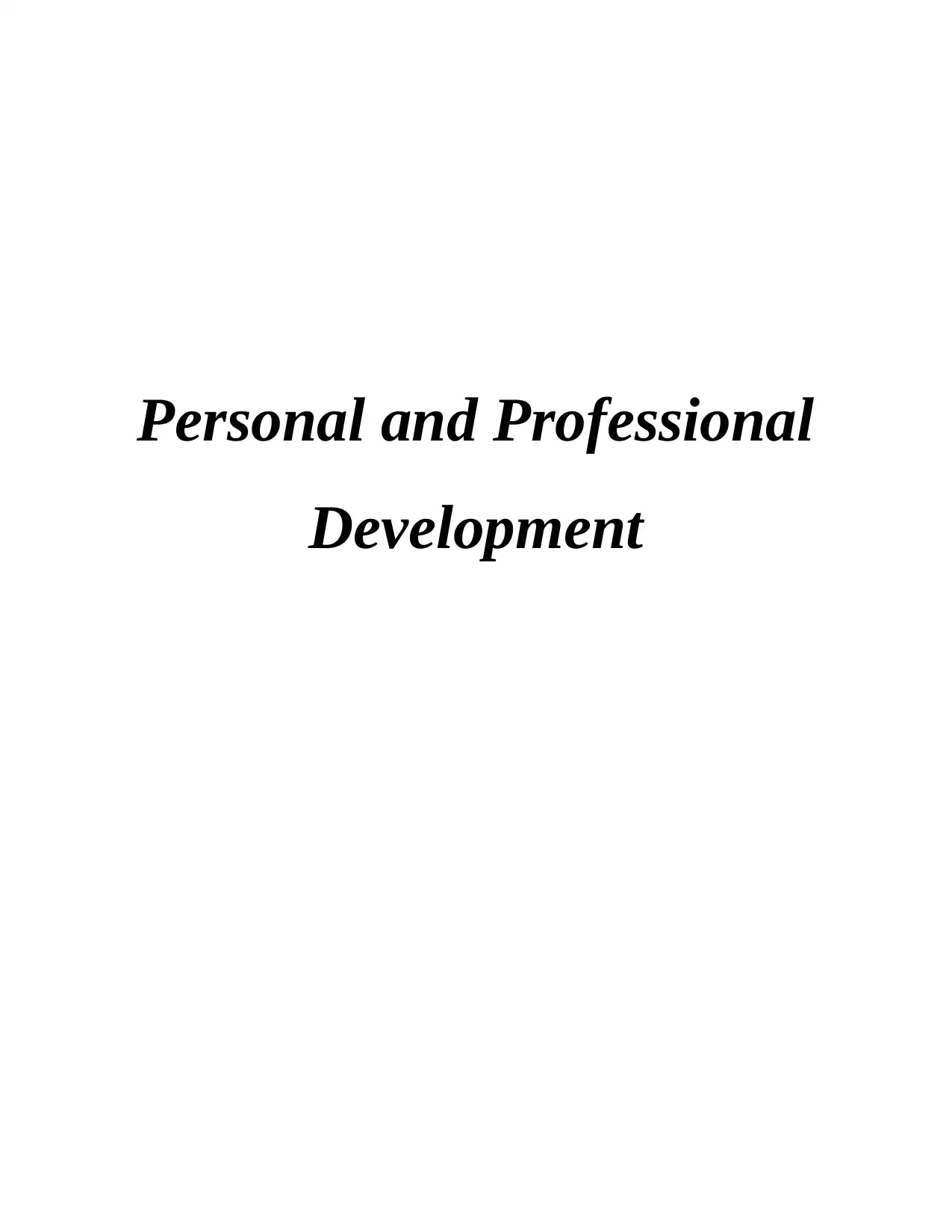
Personal and Professional
Development
Development
Paraphrase This Document
Need a fresh take? Get an instant paraphrase of this document with our AI Paraphraser
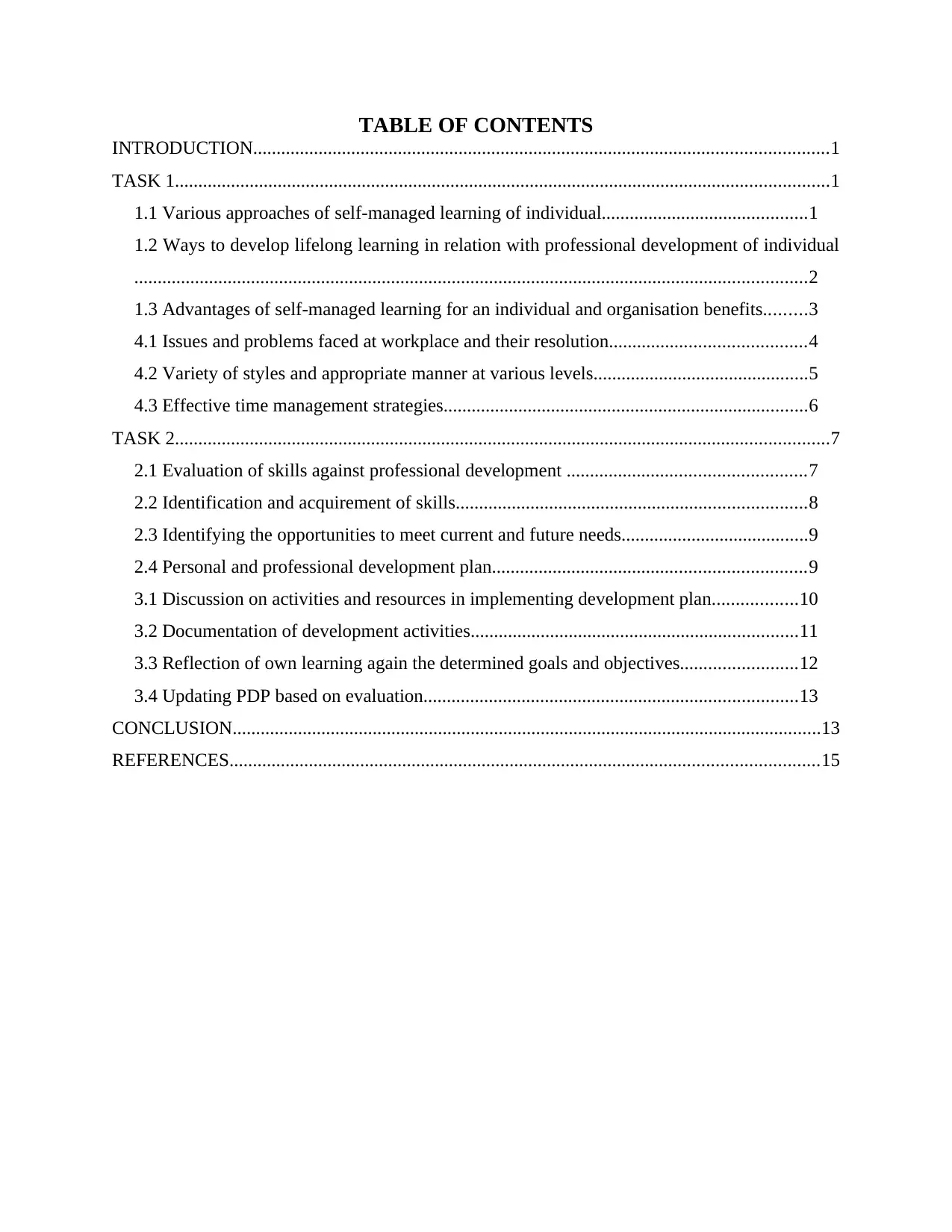
TABLE OF CONTENTS
INTRODUCTION...........................................................................................................................1
TASK 1............................................................................................................................................1
1.1 Various approaches of self-managed learning of individual............................................1
1.2 Ways to develop lifelong learning in relation with professional development of individual
................................................................................................................................................2
1.3 Advantages of self-managed learning for an individual and organisation benefits.........3
4.1 Issues and problems faced at workplace and their resolution..........................................4
4.2 Variety of styles and appropriate manner at various levels..............................................5
4.3 Effective time management strategies..............................................................................6
TASK 2............................................................................................................................................7
2.1 Evaluation of skills against professional development ...................................................7
2.2 Identification and acquirement of skills...........................................................................8
2.3 Identifying the opportunities to meet current and future needs........................................9
2.4 Personal and professional development plan...................................................................9
3.1 Discussion on activities and resources in implementing development plan..................10
3.2 Documentation of development activities......................................................................11
3.3 Reflection of own learning again the determined goals and objectives.........................12
3.4 Updating PDP based on evaluation................................................................................13
CONCLUSION..............................................................................................................................13
REFERENCES..............................................................................................................................15
INTRODUCTION...........................................................................................................................1
TASK 1............................................................................................................................................1
1.1 Various approaches of self-managed learning of individual............................................1
1.2 Ways to develop lifelong learning in relation with professional development of individual
................................................................................................................................................2
1.3 Advantages of self-managed learning for an individual and organisation benefits.........3
4.1 Issues and problems faced at workplace and their resolution..........................................4
4.2 Variety of styles and appropriate manner at various levels..............................................5
4.3 Effective time management strategies..............................................................................6
TASK 2............................................................................................................................................7
2.1 Evaluation of skills against professional development ...................................................7
2.2 Identification and acquirement of skills...........................................................................8
2.3 Identifying the opportunities to meet current and future needs........................................9
2.4 Personal and professional development plan...................................................................9
3.1 Discussion on activities and resources in implementing development plan..................10
3.2 Documentation of development activities......................................................................11
3.3 Reflection of own learning again the determined goals and objectives.........................12
3.4 Updating PDP based on evaluation................................................................................13
CONCLUSION..............................................................................................................................13
REFERENCES..............................................................................................................................15
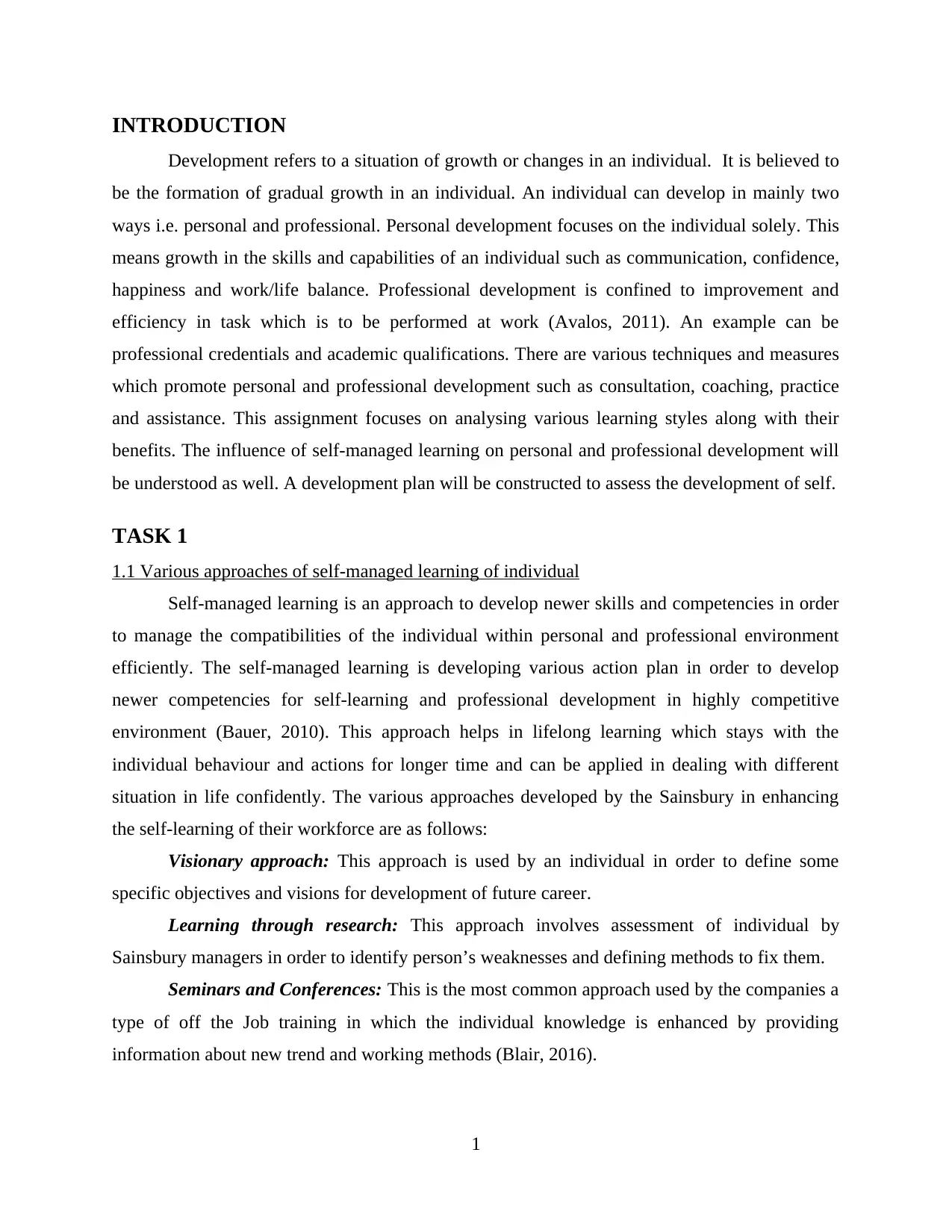
INTRODUCTION
Development refers to a situation of growth or changes in an individual. It is believed to
be the formation of gradual growth in an individual. An individual can develop in mainly two
ways i.e. personal and professional. Personal development focuses on the individual solely. This
means growth in the skills and capabilities of an individual such as communication, confidence,
happiness and work/life balance. Professional development is confined to improvement and
efficiency in task which is to be performed at work (Avalos, 2011). An example can be
professional credentials and academic qualifications. There are various techniques and measures
which promote personal and professional development such as consultation, coaching, practice
and assistance. This assignment focuses on analysing various learning styles along with their
benefits. The influence of self-managed learning on personal and professional development will
be understood as well. A development plan will be constructed to assess the development of self.
TASK 1
1.1 Various approaches of self-managed learning of individual
Self-managed learning is an approach to develop newer skills and competencies in order
to manage the compatibilities of the individual within personal and professional environment
efficiently. The self-managed learning is developing various action plan in order to develop
newer competencies for self-learning and professional development in highly competitive
environment (Bauer, 2010). This approach helps in lifelong learning which stays with the
individual behaviour and actions for longer time and can be applied in dealing with different
situation in life confidently. The various approaches developed by the Sainsbury in enhancing
the self-learning of their workforce are as follows:
Visionary approach: This approach is used by an individual in order to define some
specific objectives and visions for development of future career.
Learning through research: This approach involves assessment of individual by
Sainsbury managers in order to identify person’s weaknesses and defining methods to fix them.
Seminars and Conferences: This is the most common approach used by the companies a
type of off the Job training in which the individual knowledge is enhanced by providing
information about new trend and working methods (Blair, 2016).
1
Development refers to a situation of growth or changes in an individual. It is believed to
be the formation of gradual growth in an individual. An individual can develop in mainly two
ways i.e. personal and professional. Personal development focuses on the individual solely. This
means growth in the skills and capabilities of an individual such as communication, confidence,
happiness and work/life balance. Professional development is confined to improvement and
efficiency in task which is to be performed at work (Avalos, 2011). An example can be
professional credentials and academic qualifications. There are various techniques and measures
which promote personal and professional development such as consultation, coaching, practice
and assistance. This assignment focuses on analysing various learning styles along with their
benefits. The influence of self-managed learning on personal and professional development will
be understood as well. A development plan will be constructed to assess the development of self.
TASK 1
1.1 Various approaches of self-managed learning of individual
Self-managed learning is an approach to develop newer skills and competencies in order
to manage the compatibilities of the individual within personal and professional environment
efficiently. The self-managed learning is developing various action plan in order to develop
newer competencies for self-learning and professional development in highly competitive
environment (Bauer, 2010). This approach helps in lifelong learning which stays with the
individual behaviour and actions for longer time and can be applied in dealing with different
situation in life confidently. The various approaches developed by the Sainsbury in enhancing
the self-learning of their workforce are as follows:
Visionary approach: This approach is used by an individual in order to define some
specific objectives and visions for development of future career.
Learning through research: This approach involves assessment of individual by
Sainsbury managers in order to identify person’s weaknesses and defining methods to fix them.
Seminars and Conferences: This is the most common approach used by the companies a
type of off the Job training in which the individual knowledge is enhanced by providing
information about new trend and working methods (Blair, 2016).
1
⊘ This is a preview!⊘
Do you want full access?
Subscribe today to unlock all pages.

Trusted by 1+ million students worldwide
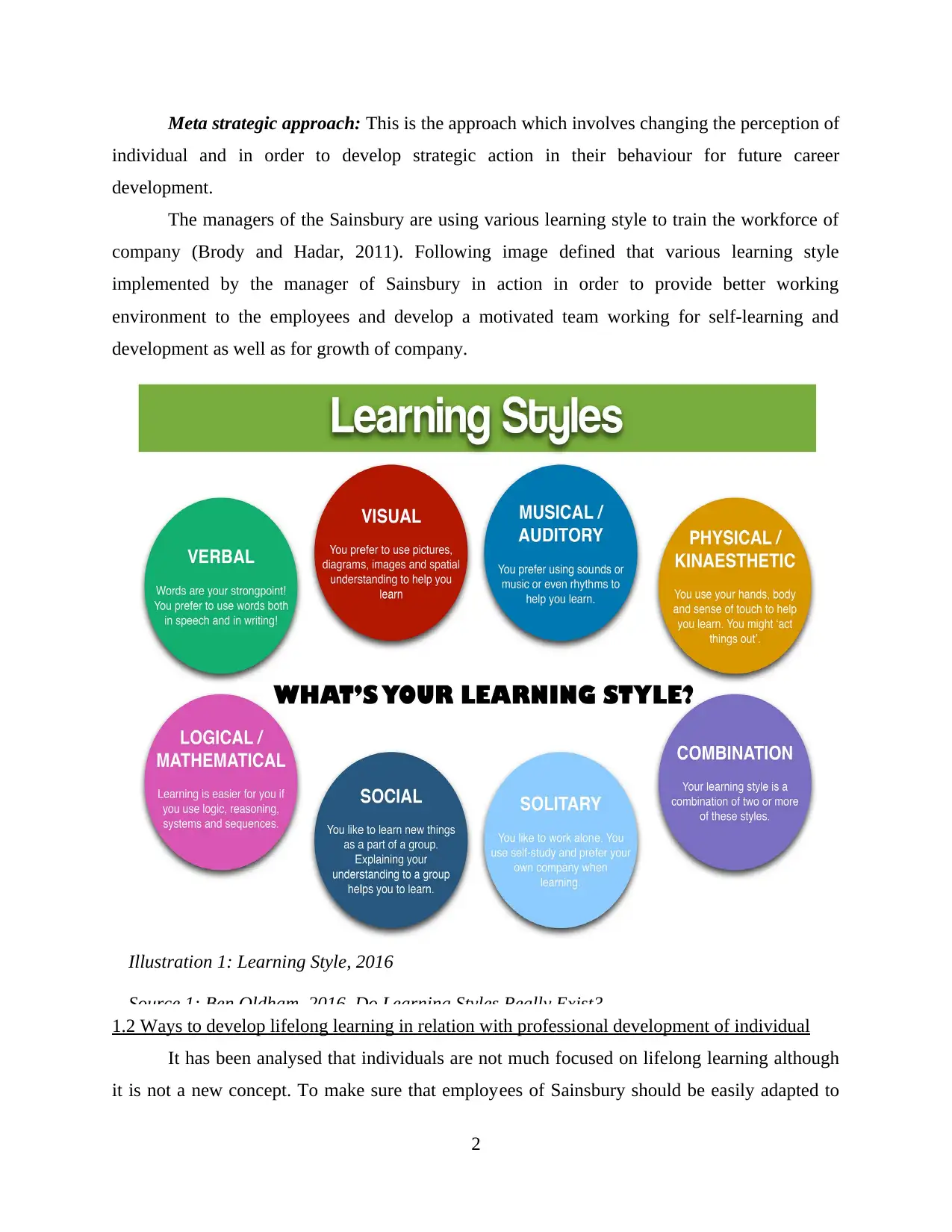
Meta strategic approach: This is the approach which involves changing the perception of
individual and in order to develop strategic action in their behaviour for future career
development.
The managers of the Sainsbury are using various learning style to train the workforce of
company (Brody and Hadar, 2011). Following image defined that various learning style
implemented by the manager of Sainsbury in action in order to provide better working
environment to the employees and develop a motivated team working for self-learning and
development as well as for growth of company.
1.2 Ways to develop lifelong learning in relation with professional development of individual
It has been analysed that individuals are not much focused on lifelong learning although
it is not a new concept. To make sure that employees of Sainsbury should be easily adapted to
2
Illustration 1: Learning Style, 2016
Source 1: Ben Oldham. 2016. Do Learning Styles Really Exist?
individual and in order to develop strategic action in their behaviour for future career
development.
The managers of the Sainsbury are using various learning style to train the workforce of
company (Brody and Hadar, 2011). Following image defined that various learning style
implemented by the manager of Sainsbury in action in order to provide better working
environment to the employees and develop a motivated team working for self-learning and
development as well as for growth of company.
1.2 Ways to develop lifelong learning in relation with professional development of individual
It has been analysed that individuals are not much focused on lifelong learning although
it is not a new concept. To make sure that employees of Sainsbury should be easily adapted to
2
Illustration 1: Learning Style, 2016
Source 1: Ben Oldham. 2016. Do Learning Styles Really Exist?
Paraphrase This Document
Need a fresh take? Get an instant paraphrase of this document with our AI Paraphraser
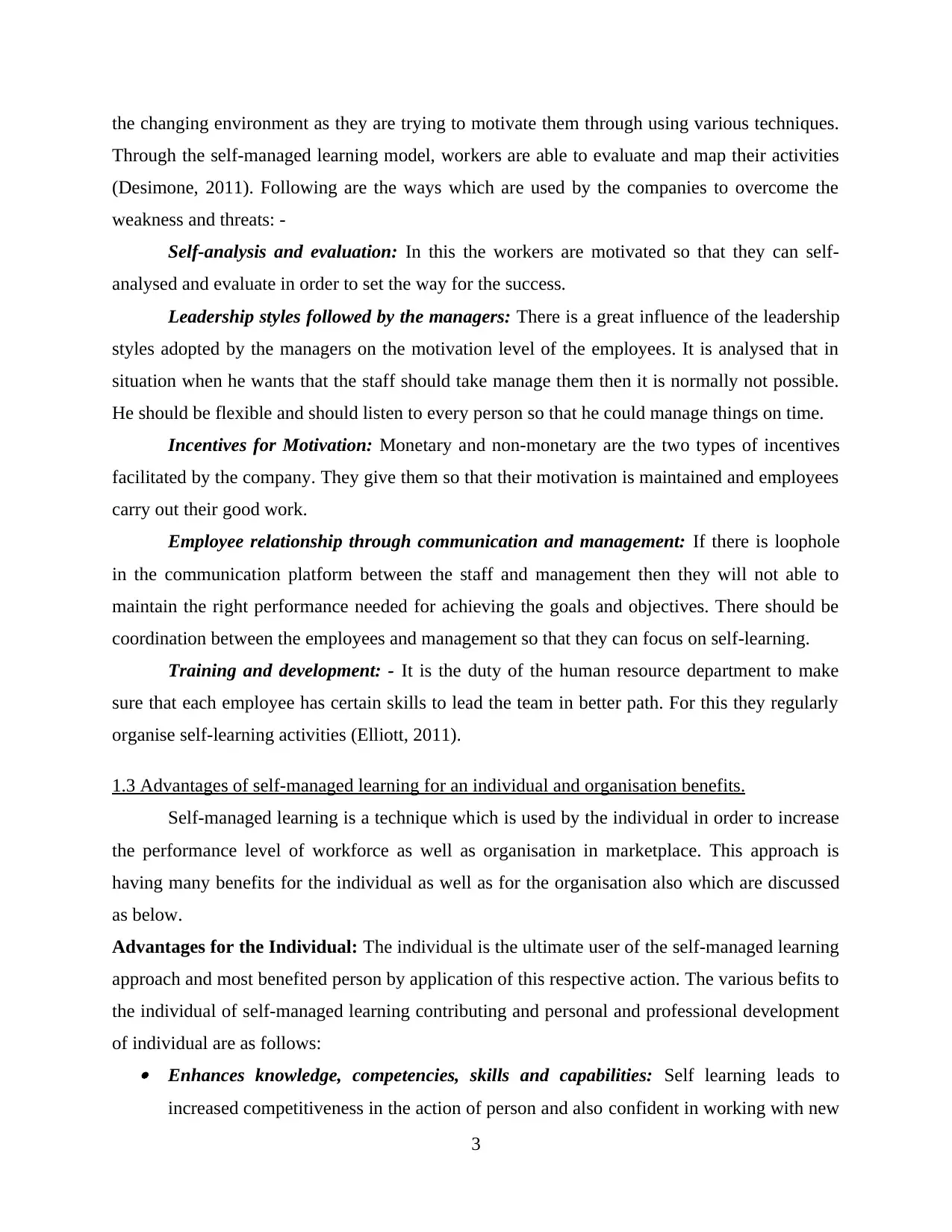
the changing environment as they are trying to motivate them through using various techniques.
Through the self-managed learning model, workers are able to evaluate and map their activities
(Desimone, 2011). Following are the ways which are used by the companies to overcome the
weakness and threats: -
Self-analysis and evaluation: In this the workers are motivated so that they can self-
analysed and evaluate in order to set the way for the success.
Leadership styles followed by the managers: There is a great influence of the leadership
styles adopted by the managers on the motivation level of the employees. It is analysed that in
situation when he wants that the staff should take manage them then it is normally not possible.
He should be flexible and should listen to every person so that he could manage things on time.
Incentives for Motivation: Monetary and non-monetary are the two types of incentives
facilitated by the company. They give them so that their motivation is maintained and employees
carry out their good work.
Employee relationship through communication and management: If there is loophole
in the communication platform between the staff and management then they will not able to
maintain the right performance needed for achieving the goals and objectives. There should be
coordination between the employees and management so that they can focus on self-learning.
Training and development: - It is the duty of the human resource department to make
sure that each employee has certain skills to lead the team in better path. For this they regularly
organise self-learning activities (Elliott, 2011).
1.3 Advantages of self-managed learning for an individual and organisation benefits.
Self-managed learning is a technique which is used by the individual in order to increase
the performance level of workforce as well as organisation in marketplace. This approach is
having many benefits for the individual as well as for the organisation also which are discussed
as below.
Advantages for the Individual: The individual is the ultimate user of the self-managed learning
approach and most benefited person by application of this respective action. The various befits to
the individual of self-managed learning contributing and personal and professional development
of individual are as follows: Enhances knowledge, competencies, skills and capabilities: Self learning leads to
increased competitiveness in the action of person and also confident in working with new
3
Through the self-managed learning model, workers are able to evaluate and map their activities
(Desimone, 2011). Following are the ways which are used by the companies to overcome the
weakness and threats: -
Self-analysis and evaluation: In this the workers are motivated so that they can self-
analysed and evaluate in order to set the way for the success.
Leadership styles followed by the managers: There is a great influence of the leadership
styles adopted by the managers on the motivation level of the employees. It is analysed that in
situation when he wants that the staff should take manage them then it is normally not possible.
He should be flexible and should listen to every person so that he could manage things on time.
Incentives for Motivation: Monetary and non-monetary are the two types of incentives
facilitated by the company. They give them so that their motivation is maintained and employees
carry out their good work.
Employee relationship through communication and management: If there is loophole
in the communication platform between the staff and management then they will not able to
maintain the right performance needed for achieving the goals and objectives. There should be
coordination between the employees and management so that they can focus on self-learning.
Training and development: - It is the duty of the human resource department to make
sure that each employee has certain skills to lead the team in better path. For this they regularly
organise self-learning activities (Elliott, 2011).
1.3 Advantages of self-managed learning for an individual and organisation benefits.
Self-managed learning is a technique which is used by the individual in order to increase
the performance level of workforce as well as organisation in marketplace. This approach is
having many benefits for the individual as well as for the organisation also which are discussed
as below.
Advantages for the Individual: The individual is the ultimate user of the self-managed learning
approach and most benefited person by application of this respective action. The various befits to
the individual of self-managed learning contributing and personal and professional development
of individual are as follows: Enhances knowledge, competencies, skills and capabilities: Self learning leads to
increased competitiveness in the action of person and also confident in working with new
3
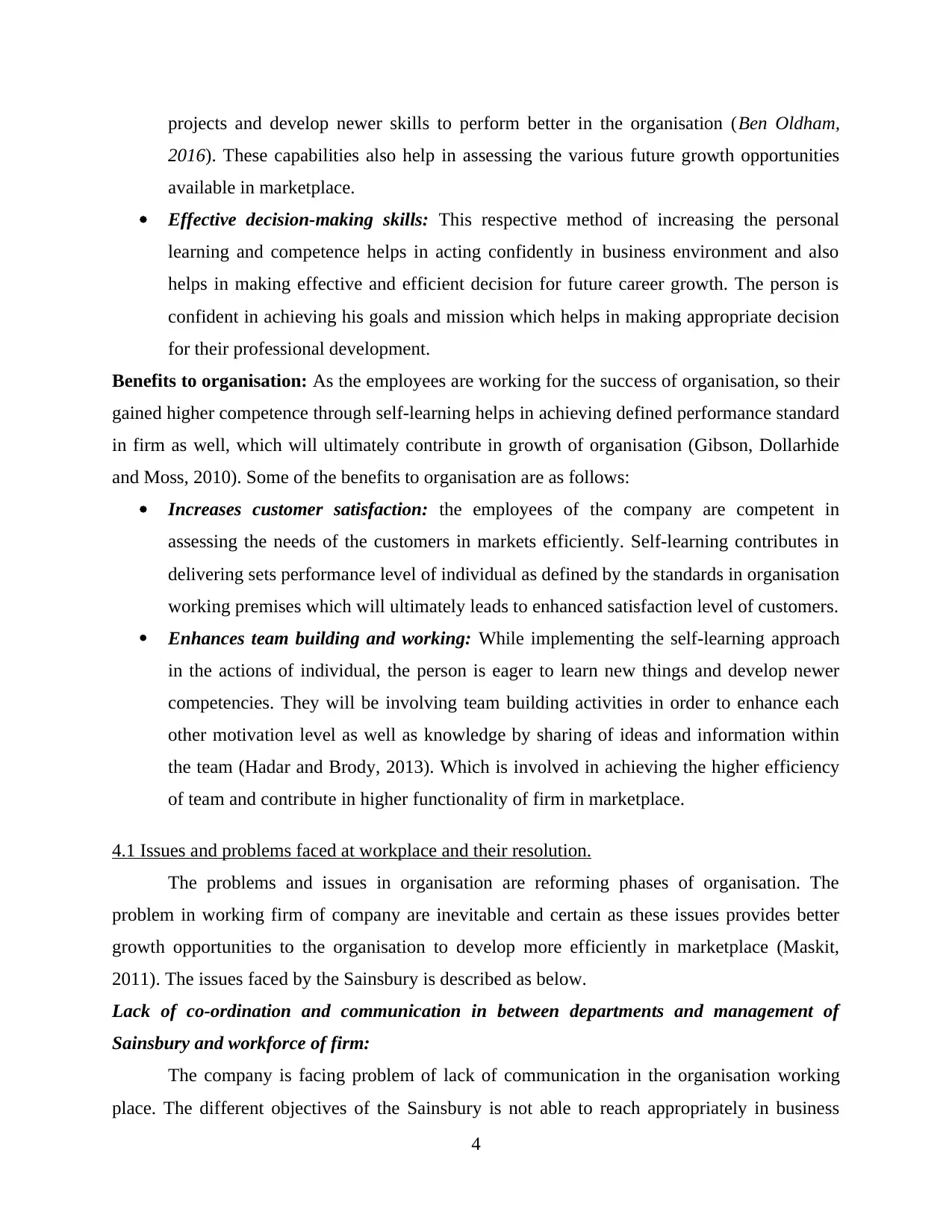
projects and develop newer skills to perform better in the organisation (Ben Oldham,
2016). These capabilities also help in assessing the various future growth opportunities
available in marketplace.
Effective decision-making skills: This respective method of increasing the personal
learning and competence helps in acting confidently in business environment and also
helps in making effective and efficient decision for future career growth. The person is
confident in achieving his goals and mission which helps in making appropriate decision
for their professional development.
Benefits to organisation: As the employees are working for the success of organisation, so their
gained higher competence through self-learning helps in achieving defined performance standard
in firm as well, which will ultimately contribute in growth of organisation (Gibson, Dollarhide
and Moss, 2010). Some of the benefits to organisation are as follows:
Increases customer satisfaction: the employees of the company are competent in
assessing the needs of the customers in markets efficiently. Self-learning contributes in
delivering sets performance level of individual as defined by the standards in organisation
working premises which will ultimately leads to enhanced satisfaction level of customers.
Enhances team building and working: While implementing the self-learning approach
in the actions of individual, the person is eager to learn new things and develop newer
competencies. They will be involving team building activities in order to enhance each
other motivation level as well as knowledge by sharing of ideas and information within
the team (Hadar and Brody, 2013). Which is involved in achieving the higher efficiency
of team and contribute in higher functionality of firm in marketplace.
4.1 Issues and problems faced at workplace and their resolution.
The problems and issues in organisation are reforming phases of organisation. The
problem in working firm of company are inevitable and certain as these issues provides better
growth opportunities to the organisation to develop more efficiently in marketplace (Maskit,
2011). The issues faced by the Sainsbury is described as below.
Lack of co-ordination and communication in between departments and management of
Sainsbury and workforce of firm:
The company is facing problem of lack of communication in the organisation working
place. The different objectives of the Sainsbury is not able to reach appropriately in business
4
2016). These capabilities also help in assessing the various future growth opportunities
available in marketplace.
Effective decision-making skills: This respective method of increasing the personal
learning and competence helps in acting confidently in business environment and also
helps in making effective and efficient decision for future career growth. The person is
confident in achieving his goals and mission which helps in making appropriate decision
for their professional development.
Benefits to organisation: As the employees are working for the success of organisation, so their
gained higher competence through self-learning helps in achieving defined performance standard
in firm as well, which will ultimately contribute in growth of organisation (Gibson, Dollarhide
and Moss, 2010). Some of the benefits to organisation are as follows:
Increases customer satisfaction: the employees of the company are competent in
assessing the needs of the customers in markets efficiently. Self-learning contributes in
delivering sets performance level of individual as defined by the standards in organisation
working premises which will ultimately leads to enhanced satisfaction level of customers.
Enhances team building and working: While implementing the self-learning approach
in the actions of individual, the person is eager to learn new things and develop newer
competencies. They will be involving team building activities in order to enhance each
other motivation level as well as knowledge by sharing of ideas and information within
the team (Hadar and Brody, 2013). Which is involved in achieving the higher efficiency
of team and contribute in higher functionality of firm in marketplace.
4.1 Issues and problems faced at workplace and their resolution.
The problems and issues in organisation are reforming phases of organisation. The
problem in working firm of company are inevitable and certain as these issues provides better
growth opportunities to the organisation to develop more efficiently in marketplace (Maskit,
2011). The issues faced by the Sainsbury is described as below.
Lack of co-ordination and communication in between departments and management of
Sainsbury and workforce of firm:
The company is facing problem of lack of communication in the organisation working
place. The different objectives of the Sainsbury is not able to reach appropriately in business
4
⊘ This is a preview!⊘
Do you want full access?
Subscribe today to unlock all pages.

Trusted by 1+ million students worldwide
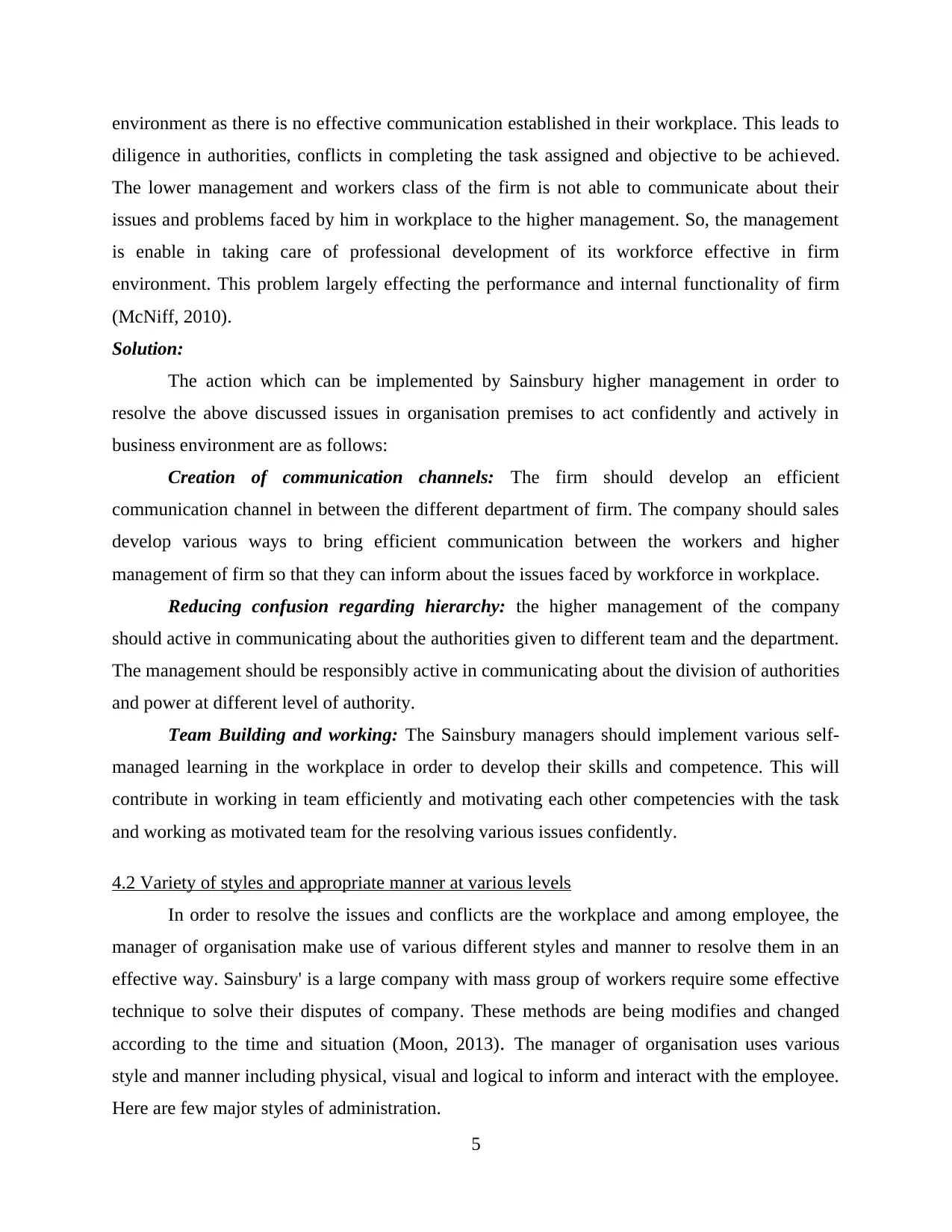
environment as there is no effective communication established in their workplace. This leads to
diligence in authorities, conflicts in completing the task assigned and objective to be achieved.
The lower management and workers class of the firm is not able to communicate about their
issues and problems faced by him in workplace to the higher management. So, the management
is enable in taking care of professional development of its workforce effective in firm
environment. This problem largely effecting the performance and internal functionality of firm
(McNiff, 2010).
Solution:
The action which can be implemented by Sainsbury higher management in order to
resolve the above discussed issues in organisation premises to act confidently and actively in
business environment are as follows:
Creation of communication channels: The firm should develop an efficient
communication channel in between the different department of firm. The company should sales
develop various ways to bring efficient communication between the workers and higher
management of firm so that they can inform about the issues faced by workforce in workplace.
Reducing confusion regarding hierarchy: the higher management of the company
should active in communicating about the authorities given to different team and the department.
The management should be responsibly active in communicating about the division of authorities
and power at different level of authority.
Team Building and working: The Sainsbury managers should implement various self-
managed learning in the workplace in order to develop their skills and competence. This will
contribute in working in team efficiently and motivating each other competencies with the task
and working as motivated team for the resolving various issues confidently.
4.2 Variety of styles and appropriate manner at various levels
In order to resolve the issues and conflicts are the workplace and among employee, the
manager of organisation make use of various different styles and manner to resolve them in an
effective way. Sainsbury' is a large company with mass group of workers require some effective
technique to solve their disputes of company. These methods are being modifies and changed
according to the time and situation (Moon, 2013). The manager of organisation uses various
style and manner including physical, visual and logical to inform and interact with the employee.
Here are few major styles of administration.
5
diligence in authorities, conflicts in completing the task assigned and objective to be achieved.
The lower management and workers class of the firm is not able to communicate about their
issues and problems faced by him in workplace to the higher management. So, the management
is enable in taking care of professional development of its workforce effective in firm
environment. This problem largely effecting the performance and internal functionality of firm
(McNiff, 2010).
Solution:
The action which can be implemented by Sainsbury higher management in order to
resolve the above discussed issues in organisation premises to act confidently and actively in
business environment are as follows:
Creation of communication channels: The firm should develop an efficient
communication channel in between the different department of firm. The company should sales
develop various ways to bring efficient communication between the workers and higher
management of firm so that they can inform about the issues faced by workforce in workplace.
Reducing confusion regarding hierarchy: the higher management of the company
should active in communicating about the authorities given to different team and the department.
The management should be responsibly active in communicating about the division of authorities
and power at different level of authority.
Team Building and working: The Sainsbury managers should implement various self-
managed learning in the workplace in order to develop their skills and competence. This will
contribute in working in team efficiently and motivating each other competencies with the task
and working as motivated team for the resolving various issues confidently.
4.2 Variety of styles and appropriate manner at various levels
In order to resolve the issues and conflicts are the workplace and among employee, the
manager of organisation make use of various different styles and manner to resolve them in an
effective way. Sainsbury' is a large company with mass group of workers require some effective
technique to solve their disputes of company. These methods are being modifies and changed
according to the time and situation (Moon, 2013). The manager of organisation uses various
style and manner including physical, visual and logical to inform and interact with the employee.
Here are few major styles of administration.
5
Paraphrase This Document
Need a fresh take? Get an instant paraphrase of this document with our AI Paraphraser
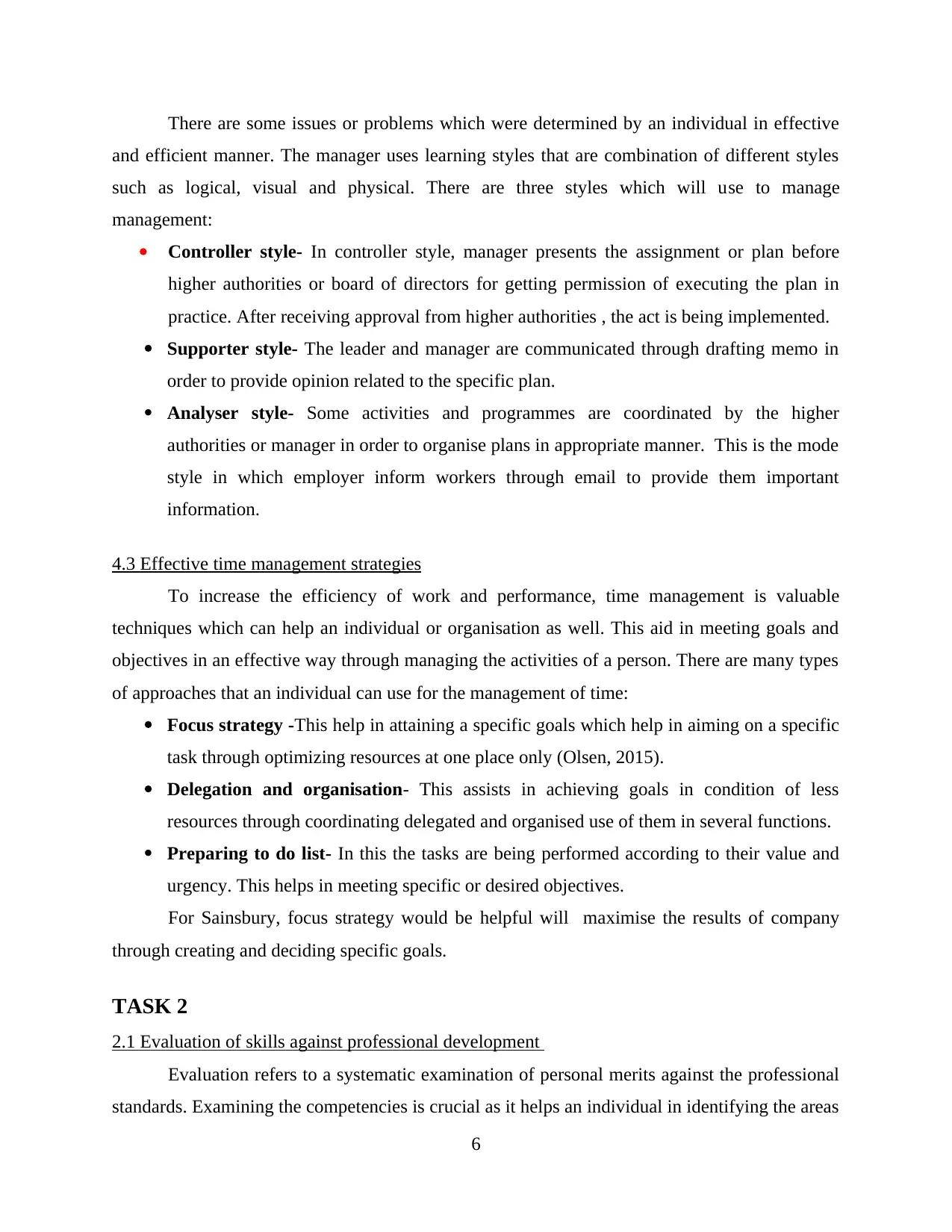
There are some issues or problems which were determined by an individual in effective
and efficient manner. The manager uses learning styles that are combination of different styles
such as logical, visual and physical. There are three styles which will use to manage
management:
Controller style- In controller style, manager presents the assignment or plan before
higher authorities or board of directors for getting permission of executing the plan in
practice. After receiving approval from higher authorities , the act is being implemented.
Supporter style- The leader and manager are communicated through drafting memo in
order to provide opinion related to the specific plan.
Analyser style- Some activities and programmes are coordinated by the higher
authorities or manager in order to organise plans in appropriate manner. This is the mode
style in which employer inform workers through email to provide them important
information.
4.3 Effective time management strategies
To increase the efficiency of work and performance, time management is valuable
techniques which can help an individual or organisation as well. This aid in meeting goals and
objectives in an effective way through managing the activities of a person. There are many types
of approaches that an individual can use for the management of time:
Focus strategy -This help in attaining a specific goals which help in aiming on a specific
task through optimizing resources at one place only (Olsen, 2015).
Delegation and organisation- This assists in achieving goals in condition of less
resources through coordinating delegated and organised use of them in several functions.
Preparing to do list- In this the tasks are being performed according to their value and
urgency. This helps in meeting specific or desired objectives.
For Sainsbury, focus strategy would be helpful will maximise the results of company
through creating and deciding specific goals.
TASK 2
2.1 Evaluation of skills against professional development
Evaluation refers to a systematic examination of personal merits against the professional
standards. Examining the competencies is crucial as it helps an individual in identifying the areas
6
and efficient manner. The manager uses learning styles that are combination of different styles
such as logical, visual and physical. There are three styles which will use to manage
management:
Controller style- In controller style, manager presents the assignment or plan before
higher authorities or board of directors for getting permission of executing the plan in
practice. After receiving approval from higher authorities , the act is being implemented.
Supporter style- The leader and manager are communicated through drafting memo in
order to provide opinion related to the specific plan.
Analyser style- Some activities and programmes are coordinated by the higher
authorities or manager in order to organise plans in appropriate manner. This is the mode
style in which employer inform workers through email to provide them important
information.
4.3 Effective time management strategies
To increase the efficiency of work and performance, time management is valuable
techniques which can help an individual or organisation as well. This aid in meeting goals and
objectives in an effective way through managing the activities of a person. There are many types
of approaches that an individual can use for the management of time:
Focus strategy -This help in attaining a specific goals which help in aiming on a specific
task through optimizing resources at one place only (Olsen, 2015).
Delegation and organisation- This assists in achieving goals in condition of less
resources through coordinating delegated and organised use of them in several functions.
Preparing to do list- In this the tasks are being performed according to their value and
urgency. This helps in meeting specific or desired objectives.
For Sainsbury, focus strategy would be helpful will maximise the results of company
through creating and deciding specific goals.
TASK 2
2.1 Evaluation of skills against professional development
Evaluation refers to a systematic examination of personal merits against the professional
standards. Examining the competencies is crucial as it helps an individual in identifying the areas
6
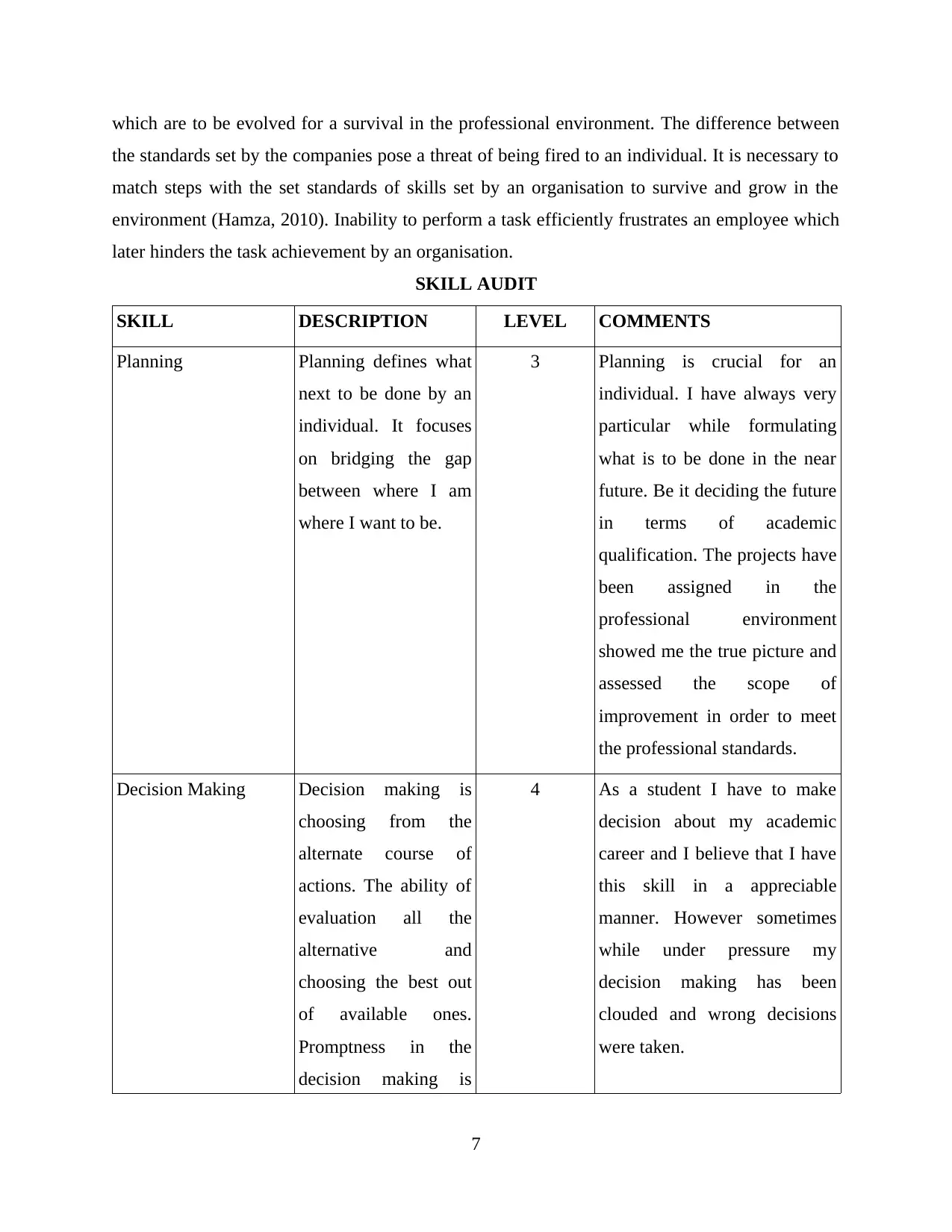
which are to be evolved for a survival in the professional environment. The difference between
the standards set by the companies pose a threat of being fired to an individual. It is necessary to
match steps with the set standards of skills set by an organisation to survive and grow in the
environment (Hamza, 2010). Inability to perform a task efficiently frustrates an employee which
later hinders the task achievement by an organisation.
SKILL AUDIT
SKILL DESCRIPTION LEVEL COMMENTS
Planning Planning defines what
next to be done by an
individual. It focuses
on bridging the gap
between where I am
where I want to be.
3 Planning is crucial for an
individual. I have always very
particular while formulating
what is to be done in the near
future. Be it deciding the future
in terms of academic
qualification. The projects have
been assigned in the
professional environment
showed me the true picture and
assessed the scope of
improvement in order to meet
the professional standards.
Decision Making Decision making is
choosing from the
alternate course of
actions. The ability of
evaluation all the
alternative and
choosing the best out
of available ones.
Promptness in the
decision making is
4 As a student I have to make
decision about my academic
career and I believe that I have
this skill in a appreciable
manner. However sometimes
while under pressure my
decision making has been
clouded and wrong decisions
were taken.
7
the standards set by the companies pose a threat of being fired to an individual. It is necessary to
match steps with the set standards of skills set by an organisation to survive and grow in the
environment (Hamza, 2010). Inability to perform a task efficiently frustrates an employee which
later hinders the task achievement by an organisation.
SKILL AUDIT
SKILL DESCRIPTION LEVEL COMMENTS
Planning Planning defines what
next to be done by an
individual. It focuses
on bridging the gap
between where I am
where I want to be.
3 Planning is crucial for an
individual. I have always very
particular while formulating
what is to be done in the near
future. Be it deciding the future
in terms of academic
qualification. The projects have
been assigned in the
professional environment
showed me the true picture and
assessed the scope of
improvement in order to meet
the professional standards.
Decision Making Decision making is
choosing from the
alternate course of
actions. The ability of
evaluation all the
alternative and
choosing the best out
of available ones.
Promptness in the
decision making is
4 As a student I have to make
decision about my academic
career and I believe that I have
this skill in a appreciable
manner. However sometimes
while under pressure my
decision making has been
clouded and wrong decisions
were taken.
7
⊘ This is a preview!⊘
Do you want full access?
Subscribe today to unlock all pages.

Trusted by 1+ million students worldwide
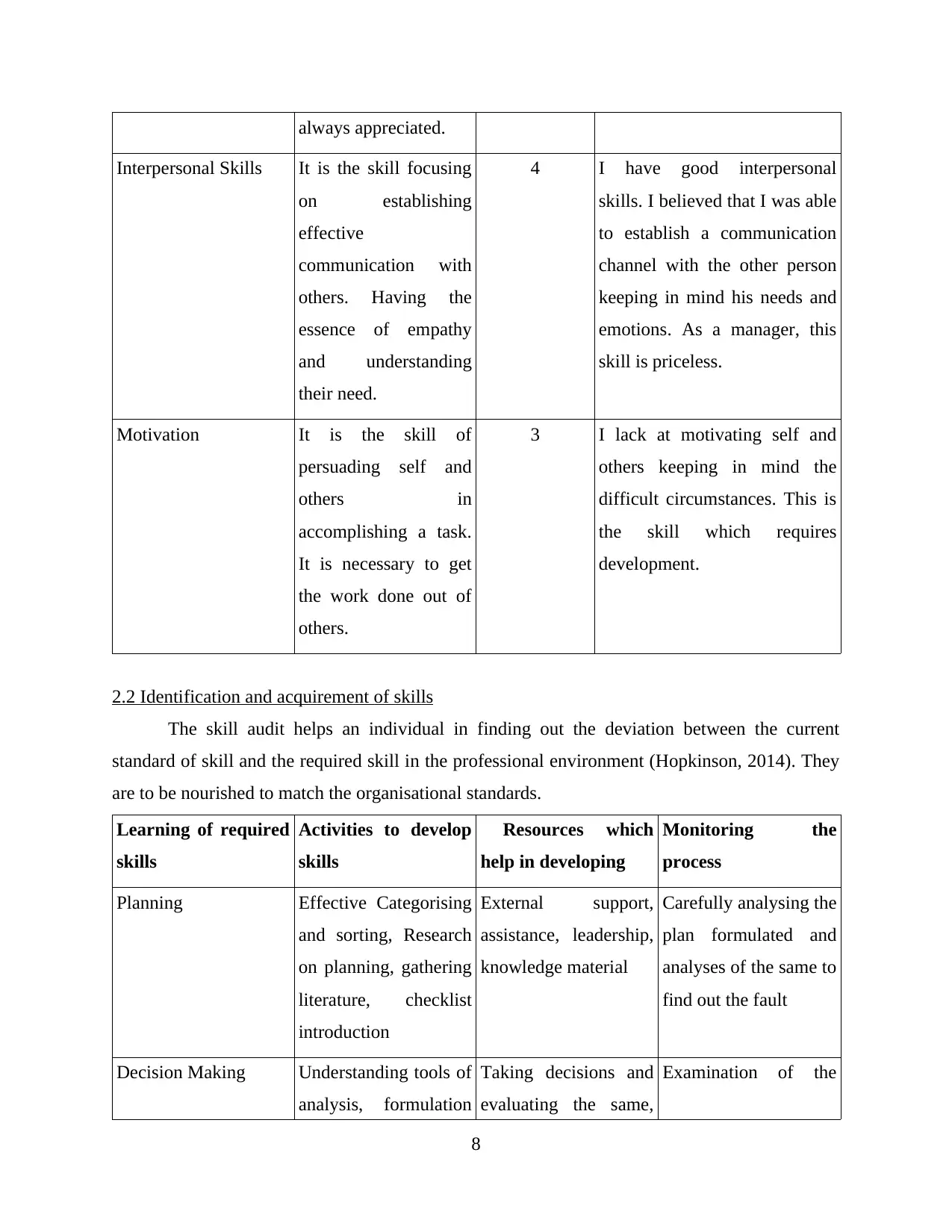
always appreciated.
Interpersonal Skills It is the skill focusing
on establishing
effective
communication with
others. Having the
essence of empathy
and understanding
their need.
4 I have good interpersonal
skills. I believed that I was able
to establish a communication
channel with the other person
keeping in mind his needs and
emotions. As a manager, this
skill is priceless.
Motivation It is the skill of
persuading self and
others in
accomplishing a task.
It is necessary to get
the work done out of
others.
3 I lack at motivating self and
others keeping in mind the
difficult circumstances. This is
the skill which requires
development.
2.2 Identification and acquirement of skills
The skill audit helps an individual in finding out the deviation between the current
standard of skill and the required skill in the professional environment (Hopkinson, 2014). They
are to be nourished to match the organisational standards.
Learning of required
skills
Activities to develop
skills
Resources which
help in developing
Monitoring the
process
Planning Effective Categorising
and sorting, Research
on planning, gathering
literature, checklist
introduction
External support,
assistance, leadership,
knowledge material
Carefully analysing the
plan formulated and
analyses of the same to
find out the fault
Decision Making Understanding tools of
analysis, formulation
Taking decisions and
evaluating the same,
Examination of the
8
Interpersonal Skills It is the skill focusing
on establishing
effective
communication with
others. Having the
essence of empathy
and understanding
their need.
4 I have good interpersonal
skills. I believed that I was able
to establish a communication
channel with the other person
keeping in mind his needs and
emotions. As a manager, this
skill is priceless.
Motivation It is the skill of
persuading self and
others in
accomplishing a task.
It is necessary to get
the work done out of
others.
3 I lack at motivating self and
others keeping in mind the
difficult circumstances. This is
the skill which requires
development.
2.2 Identification and acquirement of skills
The skill audit helps an individual in finding out the deviation between the current
standard of skill and the required skill in the professional environment (Hopkinson, 2014). They
are to be nourished to match the organisational standards.
Learning of required
skills
Activities to develop
skills
Resources which
help in developing
Monitoring the
process
Planning Effective Categorising
and sorting, Research
on planning, gathering
literature, checklist
introduction
External support,
assistance, leadership,
knowledge material
Carefully analysing the
plan formulated and
analyses of the same to
find out the fault
Decision Making Understanding tools of
analysis, formulation
Taking decisions and
evaluating the same,
Examination of the
8
Paraphrase This Document
Need a fresh take? Get an instant paraphrase of this document with our AI Paraphraser
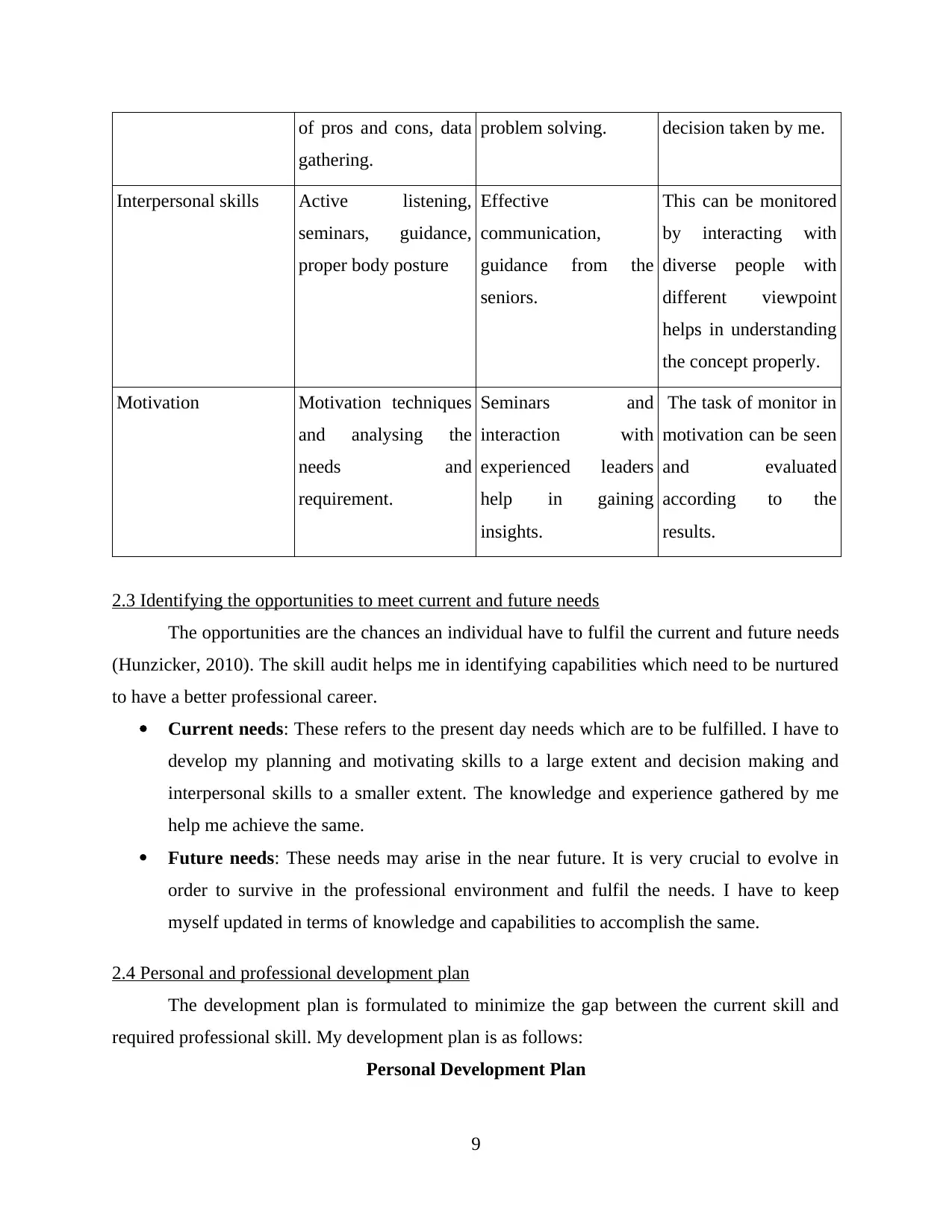
of pros and cons, data
gathering.
problem solving. decision taken by me.
Interpersonal skills Active listening,
seminars, guidance,
proper body posture
Effective
communication,
guidance from the
seniors.
This can be monitored
by interacting with
diverse people with
different viewpoint
helps in understanding
the concept properly.
Motivation Motivation techniques
and analysing the
needs and
requirement.
Seminars and
interaction with
experienced leaders
help in gaining
insights.
The task of monitor in
motivation can be seen
and evaluated
according to the
results.
2.3 Identifying the opportunities to meet current and future needs
The opportunities are the chances an individual have to fulfil the current and future needs
(Hunzicker, 2010). The skill audit helps me in identifying capabilities which need to be nurtured
to have a better professional career.
Current needs: These refers to the present day needs which are to be fulfilled. I have to
develop my planning and motivating skills to a large extent and decision making and
interpersonal skills to a smaller extent. The knowledge and experience gathered by me
help me achieve the same.
Future needs: These needs may arise in the near future. It is very crucial to evolve in
order to survive in the professional environment and fulfil the needs. I have to keep
myself updated in terms of knowledge and capabilities to accomplish the same.
2.4 Personal and professional development plan
The development plan is formulated to minimize the gap between the current skill and
required professional skill. My development plan is as follows:
Personal Development Plan
9
gathering.
problem solving. decision taken by me.
Interpersonal skills Active listening,
seminars, guidance,
proper body posture
Effective
communication,
guidance from the
seniors.
This can be monitored
by interacting with
diverse people with
different viewpoint
helps in understanding
the concept properly.
Motivation Motivation techniques
and analysing the
needs and
requirement.
Seminars and
interaction with
experienced leaders
help in gaining
insights.
The task of monitor in
motivation can be seen
and evaluated
according to the
results.
2.3 Identifying the opportunities to meet current and future needs
The opportunities are the chances an individual have to fulfil the current and future needs
(Hunzicker, 2010). The skill audit helps me in identifying capabilities which need to be nurtured
to have a better professional career.
Current needs: These refers to the present day needs which are to be fulfilled. I have to
develop my planning and motivating skills to a large extent and decision making and
interpersonal skills to a smaller extent. The knowledge and experience gathered by me
help me achieve the same.
Future needs: These needs may arise in the near future. It is very crucial to evolve in
order to survive in the professional environment and fulfil the needs. I have to keep
myself updated in terms of knowledge and capabilities to accomplish the same.
2.4 Personal and professional development plan
The development plan is formulated to minimize the gap between the current skill and
required professional skill. My development plan is as follows:
Personal Development Plan
9
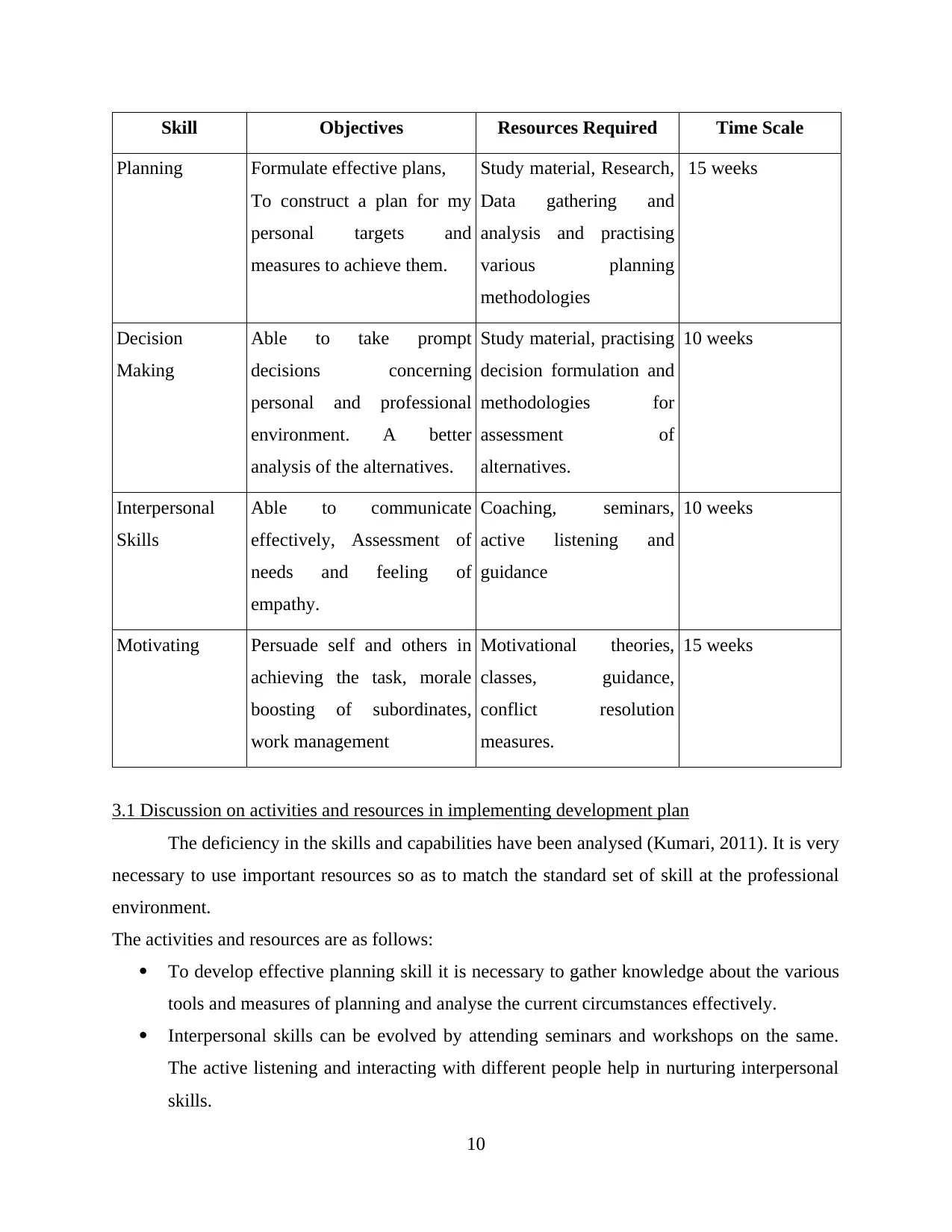
Skill Objectives Resources Required Time Scale
Planning Formulate effective plans,
To construct a plan for my
personal targets and
measures to achieve them.
Study material, Research,
Data gathering and
analysis and practising
various planning
methodologies
15 weeks
Decision
Making
Able to take prompt
decisions concerning
personal and professional
environment. A better
analysis of the alternatives.
Study material, practising
decision formulation and
methodologies for
assessment of
alternatives.
10 weeks
Interpersonal
Skills
Able to communicate
effectively, Assessment of
needs and feeling of
empathy.
Coaching, seminars,
active listening and
guidance
10 weeks
Motivating Persuade self and others in
achieving the task, morale
boosting of subordinates,
work management
Motivational theories,
classes, guidance,
conflict resolution
measures.
15 weeks
3.1 Discussion on activities and resources in implementing development plan
The deficiency in the skills and capabilities have been analysed (Kumari, 2011). It is very
necessary to use important resources so as to match the standard set of skill at the professional
environment.
The activities and resources are as follows:
To develop effective planning skill it is necessary to gather knowledge about the various
tools and measures of planning and analyse the current circumstances effectively.
Interpersonal skills can be evolved by attending seminars and workshops on the same.
The active listening and interacting with different people help in nurturing interpersonal
skills.
10
Planning Formulate effective plans,
To construct a plan for my
personal targets and
measures to achieve them.
Study material, Research,
Data gathering and
analysis and practising
various planning
methodologies
15 weeks
Decision
Making
Able to take prompt
decisions concerning
personal and professional
environment. A better
analysis of the alternatives.
Study material, practising
decision formulation and
methodologies for
assessment of
alternatives.
10 weeks
Interpersonal
Skills
Able to communicate
effectively, Assessment of
needs and feeling of
empathy.
Coaching, seminars,
active listening and
guidance
10 weeks
Motivating Persuade self and others in
achieving the task, morale
boosting of subordinates,
work management
Motivational theories,
classes, guidance,
conflict resolution
measures.
15 weeks
3.1 Discussion on activities and resources in implementing development plan
The deficiency in the skills and capabilities have been analysed (Kumari, 2011). It is very
necessary to use important resources so as to match the standard set of skill at the professional
environment.
The activities and resources are as follows:
To develop effective planning skill it is necessary to gather knowledge about the various
tools and measures of planning and analyse the current circumstances effectively.
Interpersonal skills can be evolved by attending seminars and workshops on the same.
The active listening and interacting with different people help in nurturing interpersonal
skills.
10
⊘ This is a preview!⊘
Do you want full access?
Subscribe today to unlock all pages.

Trusted by 1+ million students worldwide
1 out of 17
Related Documents
Your All-in-One AI-Powered Toolkit for Academic Success.
+13062052269
info@desklib.com
Available 24*7 on WhatsApp / Email
![[object Object]](/_next/static/media/star-bottom.7253800d.svg)
Unlock your academic potential
Copyright © 2020–2025 A2Z Services. All Rights Reserved. Developed and managed by ZUCOL.





